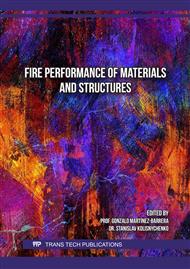p.25
p.33
p.39
p.47
p.55
p.63
p.73
p.85
p.93
Evaluation of Structural Response in Ultra-High-Strength Concrete and Carbon Fiber Reinforced Frames Exposed to High Temperatures Using Numerical Simulation
Abstract:
Reinforced concrete exposed to high temperatures, such as in a fire, poses a serious threat to buildings by weakening the concrete and reducing the structure's stiffness. Therefore, the article investigated the structural behavior of reinforced concrete when subjected to elevated temperatures in Peru, where many structures are not designed to withstand high temperatures, leading to irreparable damages such as loss of human lives and changes in material properties. To enhance the heat resistance of reinforced concrete, carbon fibers were added, and a percentage of ultra-high-strength concrete was incorporated. The material was analyzed using the finite element method. Different frames were evaluated, focusing on the use of matrices and nodes. The proposal involved adding new materials; carbon fibers were added at 0.06%, and ultra-high-strength concrete at 20%. These quantities were chosen based on the researched articles. First, the properties of each material were defined and input into the software. Then, a temperature ranges from 100°C to 1000°C was defined. The results were evaluated, and improvement percentages regarding displacements due to applied loads were determined. The findings indicate a 33.05% improvement in distributed load and temperature-induced loads between 100°C to 1000°C, varying between 17% and 6.56% respectively. It was concluded that higher temperatures result in more significant damages such as changes in color, deflections, and loss of stiffness, increasing the probability of collapse in a shorter time frame. In conclusion, the use of the proposed materials enhances resistance and reduces deflections when subjected to various types of loads.
Info:
Periodical:
Pages:
55-61
Citation:
Online since:
June 2024
Price:
Сopyright:
© 2024 Trans Tech Publications Ltd. All Rights Reserved
Share:
Citation:



